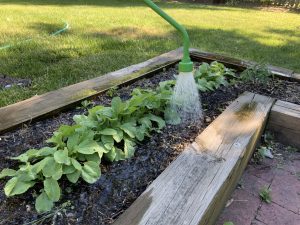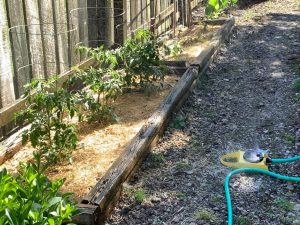Although recent rains have relieved some gardeners from their watering chores, the respite is sure to be temporary. Seasonal thunderstorms may deluge some gardens with water while other areas, even those close by, may stay fairly dry.
Most garden plants will need 1-1.5 inches of water per week to maintain healthy leaves, flowers and fruit. When Mother Nature does not provide enough, it’s up to the gardener to supply the rest. Not too little, not too much, but just right!
When you do need to water, it’s best to do a thorough deep application, and then put the hose away for the rest of the week. The worst thing you can do to your garden is to sprinkle lightly every day. Frequent, shallow watering only moistens the upper layer of soil, which encourages plant roots to stay shallow. In turn, that top layer of soil dries out quickly, making shallow-rooted plants more susceptible to drying. This holds true for lawns as well as garden and landscape plants.
It is also possible to kill your plants with kindness. Overwatering occurs when soil is kept too wet for too long, forcing valuable oxygen out of the soil. Oxygen is just as crucial to plant health as water. When heavy rains fall, or thorough irrigation is applied, don’t water again until the soil begins to dry. While you don’t want the soil to become so dry that plants begin to wilt, it is important to allow air to occupy some of the pore spaces in the soil between watering.
Newly set plants will need to be watered more frequently until they have a chance to establish new roots. Young vegetable or flower transplants may need to be watered every day or two, especially if the weather is sunny, hot and/or windy. Newly planted trees and shrubs may also need to be watered more frequently. But as the new plants become established, try to cut back on the frequency of watering.
Many plant fungal diseases are spread by splashing water during rain or irrigation. Drip or trickle irrigation will deposit the water low to the ground, keeping foliage dry; this is the most efficient way to deliver water only where needed. If watering must be overhead, try to water in the morning to promote quick drying and reduce loss due to evaporation.

